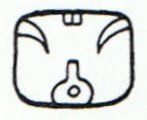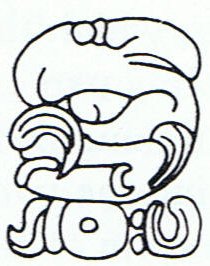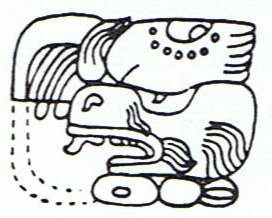 |
5 Tzec (Zec) |
 |
| "...the Aztecs made sacrifices for 'the birth of the mountains' during their equivalent month, Tepeilhuitl ..." |
 |
|
I immediately imagine I can see the sky roof coming up in the monument glyph - I can see what I hope to find. 8 short marks like the 'feather' signs in the rongorongo texts could express the sun light at last arriving down on earth. In Gates' Tzec glyph the top has opened up, another sign of sun light being allowed to enter, I imagine. The Aztecs may have thought about the phenomenon as due to the mountains pushing the sky up. |
|
"Two signs, Tzec and Pax, require the flaring open top, to distinguish them respectively from the chuen and the tun normal sign, on which they are formed." (Gates)

"The 11th day-name, in all the calendars, is Monkey: Batz in both Tzeltal and Quiché, Ozomatl in Nahuatl. The word chuen is not Maya; but on the authority of the names Hun-Batz, Hun-Chouen, the two monkey-brothers in the Popol Vuh, and the Tzeltal Chiu (given in the Ara ms. dictionary as a kind of monkey), we must accept Chuen as the original word, with this significance." (Gates)
Monkeys live in trees, and it could be an allusion to the 'Tree' now pushing the sky up. "Pictographs of monkey heads or full figures of monkeys sometimes replace the glyph for kin 'day'. This usage has been explained in terms of the associations of the Sun God with monkeys ..." Maybe the bottom middle sign in chuen is a sign to illustrate the 'sun tree' growing upwards. |
|
"The same glyph [chuen] is found to indicate the period of twenty days, known from Landa as the uinal (i.e., win-al). 'Month', however, appears in the Motul dictionary as uen, and chuen might be a compound chu-uen ..." I draw the conclusion that chu-uen, ought to mean 'sun month' (in distinction from an older moon-month), with chu = the sun. Dividing time into periods ('months') with 20 days indicates - I believe - a connection with the idea of 'fire hands', the seat of rationality and order. To see is to understand, and daylight is needed. Tzec is the 5th chuen, equal to the basic fire number (rima). The probability is high that the 'month-glyphs' in rongorongo, designed as what may be a monkey ('kiore') up in a tree (henua), represent 20 days. In other words, this may be the rongorongo 'monkey' glyph type (or uinal): 
|
Jupiter is jus-piter, father light, the 'monkey up in the tree':
| 3 * 20 = 60 days |
3 * 20 = 60 days |
 |
Moon |
 |
Mercury |
| Pop |
Zotz |
 |
Mars far away |
 |
Jupiter |
| Uo |
Tzec |
 |
Mars close |
 |
|
| Zip |
Xul |
As presented above matters seem rather convincing, but I must be intellectually honest. Three unclear points bother me and need attention:
1. The peccary in Gemini and the turtle in Orion are related, and so are Mars and Saturn. But I cannot yet understand the picture:

2. The fish representing Zotz cannot be shuffled under the mat:

Reading on in Kelley I have now been convinced the glyph really suggests a fish. The 'leaf-nose of the bat', which I thought resembled a flame, probably is intended to show a kind of fish fin. Three examples of xoc fishes in glyph compounds:



I will return to this problem soon.
3. "The Sky God has also been associated with the month Zec, where an alleged 'sky' glyph alternates with the cab 'earth' glyph. The glyph is certainly very like 'sky' and sometimes seems to occur at Palenque substituting for the regular 'sky' glyph ...
According to Landa, this month was dedicated to Hobnil, who was a bee god. Since cab may mean 'bee' as well as 'earth', I suspect that 'bee' is intended here, although Thompson suggests that there may be some connection with the 260-day cycle ..."

I have not until now showed that Kelley has an alternative monument glyph of Tzec:

Can the alternative glyph really illustrate how sky is separating itself from the close embrace of earth? Or is it the face of a bee (cab)? I will tackle this problem now.















